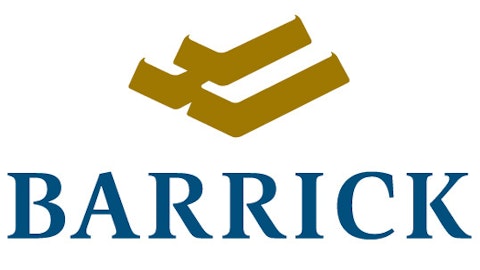Over the past 12 months, the gold mining sector has seen a tremendous amount of turmoil. Collapsing gold prices have caused many marginal producers to slash their profit forecasts or predict outsized losses for the 2013 and 2014 fiscal years. Even nominally healthy firms have been forced to lay off staff or close unprofitable facilities. Expansion plans and exploration projects have been taken off the table en masse. Very few producers have been spared.

Canadian Natural Resources Limited, Barrick Gold Corporation and Newmont Mining Corp (NYSE:NEM)
Barrick Gold Corporation (USA) (NYSE:ABX) competes directly with a number of mining companies that focus on precious and semi-precious metals. Many of these firms are based in Canada, including the massive firm to which it is selling its energy assets. Some others are not. Greenwood Village, Colorado-based Newmont Mining Corp (NYSE:NEM) falls into the latter category. Regardless of their respective home bases, these firms have plenty of similarities.
Both Barrick Gold Corporation (USA) (NYSE:ABX) and Newmont are low-cost gold producers that have mines in Canada, US, and other areas around the world. Newmont Mining Corp (NYSE:NEM) purchased Canada’s Fronteer Gold Inc in 2011 and became the second largest gold producer in the world.
Canadian Natural Resource Ltd (USA) (NYSE:CNQ), on the other hand, focuses on oil and gas exploration and production. It has grown to produce over 565,000 barrels of oil per day from 1,400 barrels about 20 years ago. Growth through exploration and acquisition has been key for the company. Now it is set to grow even more with Barrick Gold Corporation (USA) (NYSE:ABX)’s assets.
Until recently, all three were roughly the same size. After the recent drop in gold prices, Barrick and Newmont find themselves with rather depressed market valuations of $17.2 billion and $15 billion. By comparison, Canadian Natural Resource Ltd (USA) (NYSE:CNQ) has a full-strength market cap of nearly $34 billion. Strangely, Newmont still appears to be overvalued relative to its peers in the gold-mining sector. Its price-to-book ratio of 1.33 is roughly equivalent to that of Canadian Natural Resource Ltd (USA) (NYSE:CNQ) and comes in at nearly double that of Barrick.
In light of its lackluster earnings, this should be worrying for Newmont’s investors. In 2012, the firm posted a whole-year loss of $733 million on revenues of $9.1 billion. Meanwhile, Barrick lost $857 million on $14.3 billion in revenues. Canadian Natural Resource Ltd (USA) (NYSE:CNQ) remained steadily profitable: Its 2012 earnings of $1.7 billion came on over $15 billion in revenue and produced a nearly 12 percent profit margin. With long-term obligations of $9.5 billion and just over $18 million in cash, Canadian Natural Resource Ltd (USA) (NYSE:CNQ)’s biggest problem is clearly its outsized debt load.
Recent Price Action
Barrick’s plight is illustrated by its recent price action. In a rapidly rising market, the firm’s stock has experienced a nearly uninterrupted downtrend. Less than two years after touching a high near $55 per share in September of 2011, Barrick currently trades at under $20 per share. While there are encouraging signs of a technical uptrend in its recent price action, it will take some time to repair the damage that has already been done. By comparison, Canadian’s far more volatile shares have declined by just a small fraction from their 2011 highs. While this certainly is not a market-beating performance, it is far more encouraging than Barrick’s depressing showing.
How the Deal Will Happen
This deal could help Barrick recover its standing in the eyes of the market. Valued at nearly $175 million, the transaction will send several profitable energy assets to Canadian. In addition to cash consideration, Barrick will earn some potentially lucrative royalty rights on currently productive parcels in Alberta’s energy-rich hinterland. Whether these royalties justify the sale of Barrick Energy’s assets is an open question, but they do provide Barrick with a much-needed sweetener. Meanwhile, Canadian will add about 4,200 barrels per day to its oil-production capacity and about 4.4 million cubic feet per day to its natural gas-production capacity. Crucially, these assets are not tied up in expensive tar sands properties.
Implications for Barrick and Its Competitors
This transaction should give Barrick some financial breathing room. However, its $173 million price tag is not enough to change the mining landscape significantly. Indeed, even the $475 million that it stands to earn from all of its pending asset sales will fail to cover its expected losses for the year. Nevertheless, this is a step in the right direction. If nothing else, it will provide Barrick with some of the capital that it needs to invest in potentially profitable mining projects around the world. If the market for gold recovers in the near future, the company will be in better shape than many of its competitors. Investors should take note.
Long-Term Outlook and Ways to Play
Adventurous investors may see this pending deal as Barrick’s “all clear” signal. However, it would be premature to say that Barrick’s stock has bottomed out. While the company is showing clear signs of recovery and has done far more to acknowledge the “new reality” than some of its competitors, plenty of factors remain out of its control. Accordingly, the best way to play this situation may be through a long position in Canadian. Investors who believe that Canadian’s new pickups will lead to revenue and earnings growth may find the company quite cheap at these levels.
The article How Will This Asset Sale Affect the Industry? originally appeared on Fool.com and is written by Mike Thiessen.
Mike Thiessen has no position in any stocks mentioned. The Motley Fool has no position in any of the stocks mentioned. Mike is a member of The Motley Fool Blog Network — entries represent the personal opinion of the blogger and are not formally edited.
Copyright © 1995 – 2013 The Motley Fool, LLC. All rights reserved. The Motley Fool has a disclosure policy.



